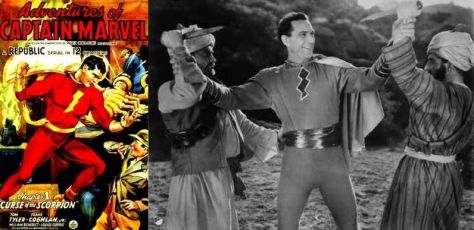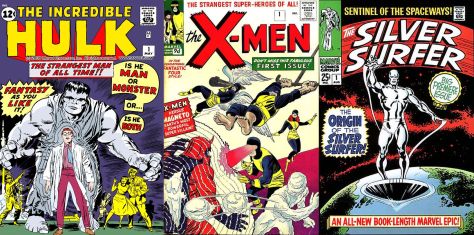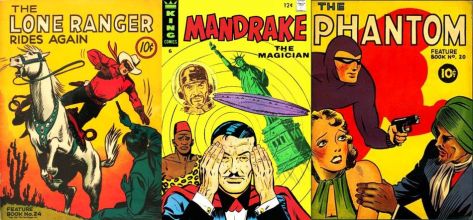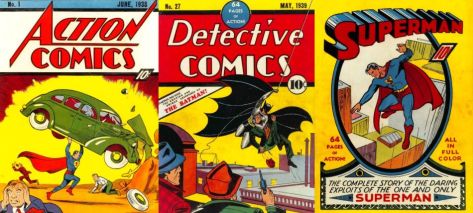1940 saw Batman become the senior partner of the dynamic duo when Robin was introduced in issue 38 of Detective Comics. The Boy Wonder attracted a younger audience that until now had been largely untapped, and sales of the publication doubled. The Green Lantern and The Flash also made their debuts in 1940, and the following year saw Wonder Woman and Aquaman introduced.
While all of the superheroes mentioned were published by National Allied (which would eventually become DC Comics), other publishers also recognised the publics’ fascination with superheroes.
Timely Comics, which would later become Marvel, introduced The Human Torch (no relation to Fantastic Four version), Namor the sub-mariner, and Captain America. Although out of the three only Captain America is well known today, during this ‘golden age of comics’, sales of each issue consistently passed the one million mark.
 However, by far the most popular comic book superhero of the time was Captain Marvel, who first appeared in Whiz Comics issue two in 1940, and was published by Fawcett Comics. Captain Marvel was to comics in the forties, as the Monkees were to music in the sixties. He was created solely to sell comic books.
However, by far the most popular comic book superhero of the time was Captain Marvel, who first appeared in Whiz Comics issue two in 1940, and was published by Fawcett Comics. Captain Marvel was to comics in the forties, as the Monkees were to music in the sixties. He was created solely to sell comic books.
Fawcett Comics circulation director Roscoe Kent Fawcett came up with an ingenious marketing ploy. At the time, Superman was the most popular comic book, but Fawcett (or someone working for him) recognised that the younger market – except for Robin – had no hero they could relate to. So he called in his staff, and demanded of them, “Give me a Superman, only have his other identity be a 10- or 12-year-old boy rather than a man”.
They came up with Captain Marvel. Or at least the third incarnation of the character created by Bill Parker in 1939, who began life as Captain Thunder, before becoming Captain Marvellous, and finally Captain Marvel.
Like Superman, Captain Marvel could fly, had super strength, and speed, and had an alter ego who worked for a newspaper. Unlike Clark Kent though, his secret identity was a 12 year old homeless boy named Billy Batson, who sold newspapers.
Captain Marvel was an instant success, and was soon the highest selling comic book in the United States. He was even outselling Superman, and at the peak of his popularity, approximately 1.4 million copies of each issue of Captain Marvel were sold.

Such was the public’s fascination in Captain Marvel, in 1941, a 12 part film serial was produced. Making him the first ‘real’ Superhero to appear on screen.
Hoping to take full advantage of the massive popularity of superheroes, publishers wanted more of them. Two of the more enduring characters created during this time were the Green Lantern, who made his debut in 1940, and the Green Arrow, who made his first appearance in More Fun Comics in 1941.
Towards the end of the 1940s, sales and interest in superhero comic books began to decline. However three superheroes did make their debuts on the big screen in that decade. Batman (1943), Captain America (1944), and Superman (1949), were all featured in film serials.
Then in 1952, Superman made his television debut in ‘The Adventures of Superman’, starring George Reeves as the Man of Steel. The television series ran for six seasons, the last three of which were filmed in colour.
The success of the series slowly rekindled the public’s interest in superhero comic books. In a bid to capitalise on this, DC’s Robert Kanigher and Carmine Infantino reimagined the Flash. Although perhaps a risk, it paid off. Sales of superhero comics increased quite dramatically, and this surge was the beginning of the ‘silver age of comics’, which would last throughout the 1960s, and into the early 1970s.
The 1960s began with the formation of the Justice League, who appeared for the first time in ‘The Brave and the Bold’ issue 28, in 1960. The ‘League’ brought together DC’s Superman, Batman, Wonder Woman, Green Lantern, The Flash, Aquaman and Martian Manhunter, to battle the evil alien, ‘Starro’.
Although DC had previously introduced the Justice Society in 1944, it was predominately a permanent band of minor heroes, which occasionally featured major superheroes such as the Flash and Green Lantern. The name was changed to the Justice League, and the minor heroes were replaced with DC’s major heroes. The concept was a resounding success.
In 1961, Atlas Comics, along with its subsidiaries merged, and formed Marvel Comics. Although Marvel’s first offering was a science fiction comic, the success of the Justice League prompted editor in chief Stan Lee to create the Fantastic Four in 1941. This began a hugely successful era for Marvel when the majority of their most iconic superheroes were created.
The team at Marvel, which included Lee, Jack Kirby and Steve Ditko introduced Spiderman and The Hulk in 1961. The following year saw the debuts of both Ironman and the X-men, as well as The Avengers (Marvels version of DC’s Justice League). The Avengers originally included Iron Man, Ant-Man, the Wasp, Thor, and the Hulk, with Captain America joining soon after. This was followed by the introduction of Daredevil in 1964, and the Silver Surfer in 1965.
With such a prolific output of iconic superheroes during this short period of time, it is no surprise the sixties are sometimes referred to as the ‘Marvel Age’, by comic historians.
Then in 1965 Lorenzo Semple Jr was approached by then ABC producer William Dozier, to help bring Batman to the small screen. Although television executives expected a gritty drama, Dozier and Semple Jr. gave them an outrageously camped up and comedic adaptation of the caped crusader.
The series premiered in 1966, and ran for three seasons, made up of 120 episodes. Such was its popularity, it aired twice weekly during the first two seasons.
Starring Adam West as Batman, and Burt Ward as Robin, the series also boasted a talented array of guest actors, who lined up to play the various villains on the show. Caesar Romero, Eartha Kitt, Burgess Merideth, Julie Newmar, Frank Gorshin and Vincent Price all starred as adversaries of the dynamic duo at different times.
The popularity of the television show was transferred to comic book sales, and by the end of the sixties, the superhero comic book industry was the healthiest it had been since the late 1930’s and early 1940s.




















